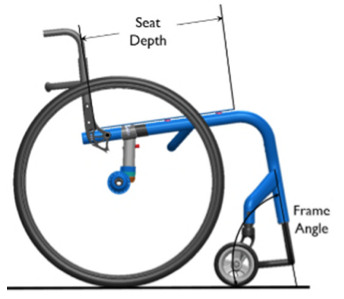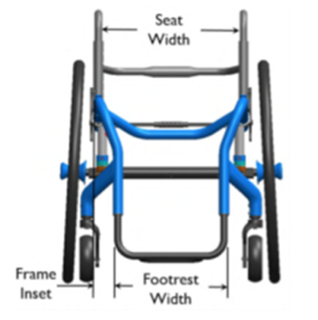Share:
Last month, Clinical Corner addressed frame length in rigid frame wheelchairs. The difference between standard and classic frame lengths and the resulting effects on wheelbase, turning radius and maneuverability were reviewed. If you missed that article, click here to read it. This month, Clinical Corner will address frame angle and front inset on rigid frame wheelchairs and some of the key considerations associated with them.
Let's start with frame angle. As the graphic below illustrates, frame angle relates to the angle of the front frame relative to the horizontal plane. Some choices offered include 75, 80 and 85 degrees. Because the frame is one piece, the effective frame angle is dependent upon the difference in seat surface height from the front edge of the seat sling to the rear edge of the seat sling (i.e., the seat slope) in a configured rigid frame wheelchair. It is assumed that there is a difference of 2 inches in seat surface height from the front edge of the seat sling to the rear edge of the seat sling (i.e., rear seat to floor height is 2 inches lower than front seat to floor height). A difference of significantly more or less than 2 inches of seat slope may slightly alter the effective angle of the frame on a configured rigid frame wheelchair.

The main consideration in selecting frame angle is the desired positioning of the lower extremities. This correlates to selecting the angle of the lower leg support assembly (i.e., hanger or front rigging) in a folding frame wheelchair to support the lower extremities in the desired thigh to lower leg angle. The choice of frame angle will affect the overall length of the rigid frame wheelchair, which will have an effect on the turning radius, as well as how close the individual using the rigid wheelchair will be able to approach objects in front of them.
Next, let's look at frame inset. Frame inset is the distance from the outside of the seat tube to the outside of the foot support, as shown in the graphic below. The frame inset will dictate the overall width of the foot support. The front end of the wheelchair may or may not be tapered as choices offered include 0, 1 or 2 inches of inset per side.

In a folding frame wheelchair that has swing in/swing out foot supports, the foot supports can be moved out of the way for transfers or to get closer to objects. In a rigid wheelchair, the front end is fixed, which is why thoughtful consideration should be given for the inset. The choice of inset will influence the maneuverability of the wheelchair in tight spaces and the ability to get close to surfaces from the side, for example, for transfers. When selecting the inset, it is important to ensure that contact will not made with the bony prominences of the knees or ankles or the fleshy parts of the lower extremities with the down tubes of the front frame to avoid the potential for pressure injuries.
Summary
This month, Clinical Corner has addressed frame angle and inset on rigid frame wheelchairs, including what they are and the key considerations when making selections on an order form to address fit and function for an individual.
As always, please provide your comments, questions and suggestions regarding Clinical Corner. Please email me at Sheilagh.Sherman@sunmed.com. I look forward to hearing from you!
Sheilagh Sherman, BA, BHScOT, MHM, OT Reg. (Ont.)
Clinical Education Manager
Sunrise Medical Canada
Note: The content of this article is not meant to be prescriptive; rather, it is meant as a general resource for clinicians to then use clinical reasoning skills to determine optimal solutions for individual clients. Sheilagh is unable to answer questions from members of the general public. Members of the general public are directed to their own therapists or other health care professionals to ask questions regarding needs.
This article is © Sunrise Medical, Inc., 2020 and cannot be copied, distributed, or otherwise reproduced in whole or in part without the express written permission of Sunrise Medical Canada.